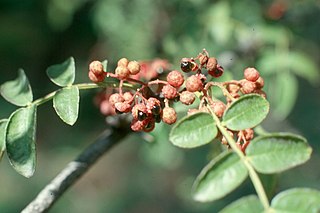
Zanthoxylum is a genus of about 250 species of deciduous and evergreen trees, shrubs and climbers in the family Rutaceae that are native to warm temperate and subtropical areas worldwide. It is the type genus of the tribe Zanthoxyleae in the subfamily Rutoideae. Several of the species have yellow heartwood, to which their generic name alludes. Several species are cultivated for their use as spices, notably including Sichuan pepper.
Thomas Gordon Hartley was an American botanist.

"Uzazi" is the Nigerian name for the 'prickly ash' tree of genus Zanthoxylum tessmannii / Fagara tessmannii / Zanthoxylum gilletii, a member of the Rutaceae family, native to Central and West Africa, and a close relative of the Sichuan pepper. It usually refers specifically to the spice made from its fruit and pericarp, though sometimes other parts of it such as its leaves are used.
Alsodeiopsis schumannii is a species of plant in the Icacinaceae family. It is endemic to Tanzania, specifically the East Usambara, the Uluguru Mountains, and the Southern Highlands.

Esenbeckia is a genus of flowering plants in the rue family, Rutaceae. All species in the genus are native to the Americas, with the highest diversity in South America. They are commonly known as jopoy, the Mayan word for E. berlandieri, or gasparillo (Spanish).
Zanthoxylum mayu, synonym Fagara mayu, is a species of plant in the family Rutaceae. It is endemic to Chile. It is threatened by habitat loss.
Zanthoxylum mezoneurispinosum, synonym Fagara mezoneurispinosa, is a species of plant in the family Rutaceae. It is endemic to lowland tropical rainforests of Ivory Coast.
Vepris heterophylla is a species of plant in the family Rutaceae. It is found in Burkina Faso, Cameroon, Ghana, and Mali. It is threatened by habitat loss.
Vepris sansibarensis is a species of plant in the family Rutaceae. It is found in Kenya and Tanzania.
Zanthoxylum deremense is a species of plant in the family Rutaceae. It is found in Malawi and Tanzania.
Zanthoxylum mollissimum is a species of plant in the family Rutaceae. It is found in Belize, Costa Rica, El Salvador, Guatemala, Honduras, Nicaragua, and Panama.

Zanthoxylum caribaeum is a species of plant in the family Rutaceae. It is found in Belize, Guatemala, and Honduras.
Zanthoxylum spinosum subsp. hartii is a species of plant in the family Rutaceae. It is endemic to Jamaica.
Zanthoxylum holtzianum is a species of plant in the family Rutaceae. It is endemic to Tanzania.
Zanthoxylum lindense is a species of plant in the family Rutaceae. It is endemic to Tanzania.

Zanthoxylum punctatum, also known as the St. Thomas prickly-ash, is a species of plant in the family Rutaceae. It is found in Puerto Rico, the British Virgin Islands, and the United States Virgin Islands. Its natural habitats are tropical and subtropical dry broadleaf forests and shrublands. It is threatened by habitat loss, and is the only on St. John listed as "endangered".

Buchanania obovata is a small to medium-sized understorey tree in woodlands native to northern Australia, in particular in Arnhem Land in the Northern Territory. Common names include green plum and wild mango.

Zanthoxylum americanum, the common prickly-ash, common pricklyash, common prickly ash or northern prickly-ash, is an aromatic shrub or small tree native to central and eastern portions of the United States and Canada. It is the northernmost New World species in the citrus family, Rutaceae, and is the type species in its genus, which includes sichuan pepper. It can grow to 10 meters (33 ft) tall with a diameter at breast height (DBH) of 15 cm (5.9 in). It produces membranous leaflets and axillary flower clusters. The wood is not commercially valuable, but oil extracts from the bark have been used in traditional and alternative medicine, and have been studied for antifungal and cytotoxic properties. The genus name is sometimes spelled Xanthoxylum.
Lasiodiscus fasciculiflorus is a species of shrub or small tree in the family Rhamnaceae that is native to forests of the West African tropics. It occurs from Sierra Leone to Nigeria and the D.R.C. The bark is used in medicine to treat various ailments.

Zanthoxyloideae is a subfamily of the family Rutaceae.









